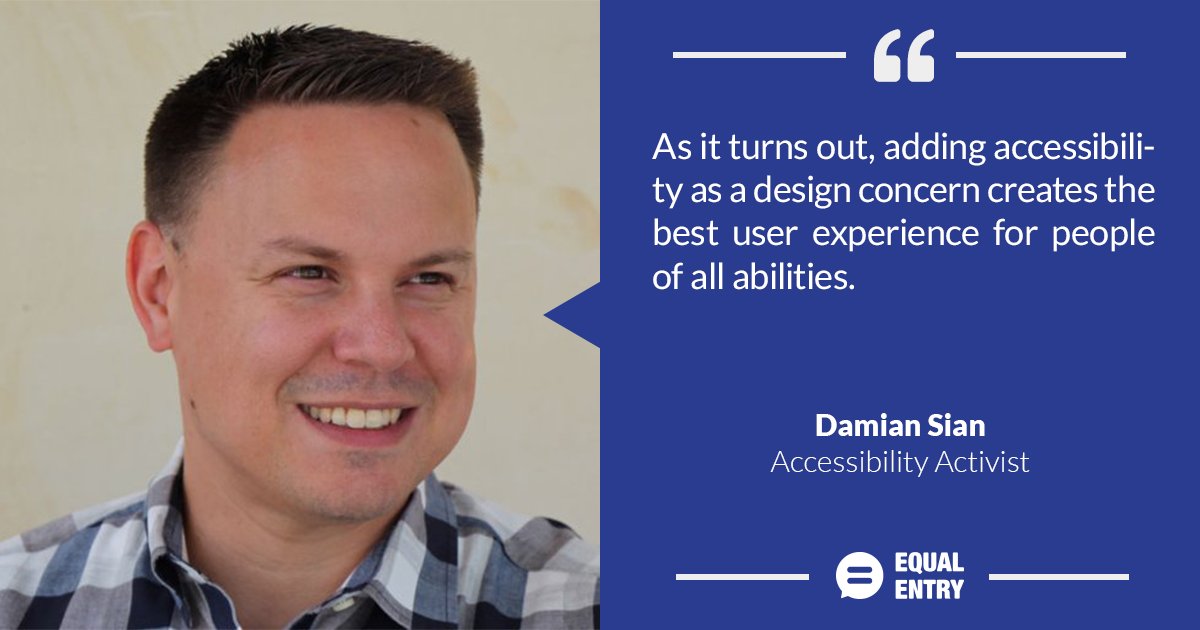Summary

This installment of our Accessibility Activists column is an interview with Damian Sian, Senior Web Accessibility Advisor for Princeton University. Sian is also the owner of Creative AP, a corporate communications consulting firm dedicated to helping small businesses have a big impact.
When did you first get started in accessibility?
My first introduction to accessibility was with the Educational Testing Services (ETS) building an accessible test preparation product for the state of Georgia. At the time, I was leading the project in the role of Project Manager, and accessibility was just a layer of that project’s requirements. As it turns out, adding accessibility as a design concern created the best User Experience for people of all abilities. For example, I pushed for a solution to add Math Ml support to the test prep tool, instead of tagging images of math expressions with alt text. This made the tool lighter and more flexible while increasing the functionality. It was the drive to create an experience fair and inclusive to all that ending up leading to a superior product overall.
From there, the door was opened to a new facet of my career that I plan to make the focus of my remaining working life: providing inclusion through User Experience design. Civil rights and social justice were always interests of mine, but I never had an outlet for those interests professionally until Web Accessibility presented that opportunity. The field of Web Accessibility pulled together all the strengths that I’ve worked hard to cultivate over the years such as: process development, operational excellence, graphic communications, and delivering effective training.
You worked for Baldwin & Obenauf, a marketing and advertising agency, for six years. During that time, did you notice or encounter any accessibility issues that would affect your thinking going forward?
Working in a creative agency, I had zero interaction with Web Accessibility. We were focused on delivering effective communications on a visual and branding level for purposes of marketing. As such, we were not focusing heavily on the underlying structure and integrity of the creative. Instead, we were mainly focused on the visual presentation, and the subsequent return on investment for our clients. Web Accessibility however demands that we pay attention to those areas that are “invisible” to our clients. This concept would be viewed as intangible to the creative agency, as its focus would seem too granular to invest so much resource toward.
What my career in the agency world did prepare me for was adaptation through innovation while under immense pressure. The creative agency is a crucible; the pressures sustained in that space either break people or make them strong. Combine that with working within regulated industries like pharma and medical device, and my creative agency experience was the perfect place to prepare me for the field of Web Accessibility. When backed into a corner, I never had the ability to say no. Instead, when I faced an obstacle, I innovated solutions. That life lesson has served me well when attempting to find ways to create multi-modal communication strategies. Because of that training, I am less likely to back down from challenges, and will instead work hard to find solutions. In addition, working in a creative agency taught me the foundations of communications, which have been an aid in deconstructing the problems faced in Web Accessibility to their discrete elements, which leads to effective and efficient solution development.
You are the Senior Web Accessibility Advisor at Princeton University. Before that, you were the Senior UX Designer and Web Accessibility SME for a financial institution. Do the accessibility concerns of a university differ from the concerns of the financial sector? If so, how?
What I found to be dramatically different between the corporate world and higher education is the approach to collaboration. In the corporate world, finding solutions to Web Accessibility challenges is a seen as a competitive advantage. This is in direct opposition to the higher education space where we are fully encouraged to share that information for the betterment of the industry. Higher education is all about collaboration and that has been the largest culture shock for me thus far.
For example, I am on several “listservs” now where higher ed folks from around the country ask questions and share ideas freely. In my past role within finance, I would have never thought to ask someone at another finance company to sandbox ideas, strategies, and solutions to Web Accessibility challenges. But having that level of openness will help with progressing our industry much farther and much more quickly, so I’m happy I made the move.
What accessibility barrier would you like to see solved?
I would like to see more work being done around representing data visualizations in different modalities. Whether it is a simple chart/graph, or a complex illustration of a mathematical concept, providing inclusion in this space is difficult. There are no solutions out there for the non-technical content author to provide an equivalent experience with “off the shelf” tools.
Also, I’d like to have access to usability testing from the perspective of users with diverse abilities. As a professional in this field, I don’t have an effective feedback loop today to understand what is working well for folks with assistive technology, and what is causing frustration. Whereas this is not a full barrier, simply developing content that meets the letter of the WCAG standard doesn’t help me create exceptional experiences in addition to achieving compliance. I am working with the NJ Commission for the Blind to set up usability testing, but this is just one underrepresented user that I’m working to include into a unified and inclusive design framework. Ideally, I’d like to learn from the diversity of our audiences and integrate their needs and wants into the foundation of our designs process as a pillar that strengthens the full User Experience.